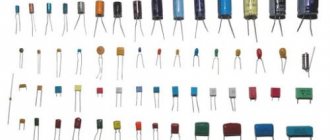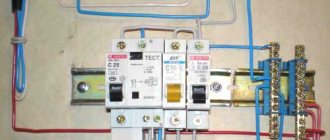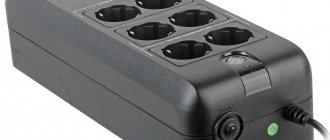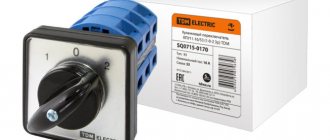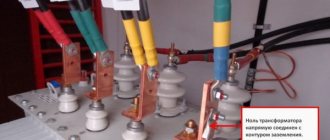Protection against electric shock using a differential circuit breaker
Modern society is characterized by the widespread use of a variety of electrical equipment.
There are often cases when newly purchased equipment is connected to wiring that is not designed for high current consumption. Another situation: instead of expensive devices from well-known manufacturers, in order to save money, designs from little-known brands are purchased. Unscrupulous manufacturers reduce the cost of products to the detriment of quality. In order to increase human safety and prevent fires, a variety of protection devices have been developed.
Nominal value and class of the difavtomat
These indicators answer the questions:
- How quickly will the automat operate when overloaded?
- At what current value will the automatic circuit breaker operate?
On the market you can find classes A, B, C, D. A is the fastest, D is the longest. For domestic use, mainly class B and class C are used. Why is this so? If you install a class A machine in your apartment (although it costs several times more than B and C), then every time you turn on the vacuum cleaner, the automatic machine will work. This is due to the fact that when the vacuum cleaner is started, the current in the network increases sharply for a short period of time. But class A is very sensitive and therefore will work immediately.
If you set class D, the device will not respond quickly enough.
As for the nominal value, it all depends on your tasks.
Diphavtomats with a rating of 16 amperes are installed on the line of sockets. For the lighting line - rated at 10 amperes.
Test button
Must be present on all automatic machines. Simulates current leakage. Manufacturers recommend pressing it at least once every three months.
Trigger type
This characteristic means what currents the difavtomat reacts to.
Type A - such a device responds to alternating and pulsed current. It costs several times more than the AC type. Sometimes washing machine manufacturers recommend installing such devices on the washing line. The reason for this is that the washing machine creates a pulse current (that is, current, then not).
AC type is the most popular option. Responsive to alternating current.
Everything is simple here - if there are no special instructions or devices - install AC type automatic machines.
Leakage current
This indicator indicates how sensitive the automatic machine is. As a rule, difavtomats with a leakage of 30 mA (milliamps) are used. This is taken into account optimally for human protection - not too sensitive for false alarms, but sensitive enough to protect a person from electric shock. MUCH less often you can find 10, 100 and 300 mA difautomats. We believe that this is due to the demand for devices.
Device type of difavtomat
This characteristic means how the difavtomat reacts to current leakage. There are two main categories here
Electromechanical automatic machines.
The most popular option. As a rule, they cost more than electronic ones. Such automatic devices trigger a leak regardless of the presence of voltage in the network. They are considered more reliable solutions.
Electronic automatic machines.
This type of device reacts only when there is voltage in the network. This means that if the zero is broken, the difavtomat will not protect against current leakage. Such automatic machines are presented in the Legrand RX and Schneider Easy9 series.
In order to understand what type of automatic machine is in front of you, you need to study the diagram.
For electronic automatic devices, the operating diagram always shows a circuit board with an amplifier in the form of a triangle (this is a symbol for amplifiers according to GOST).
We recommend using electromechanical automatic machines. They are more reliable and are not much more expensive than electronic ones.
What is a differential automatic and what is it for?
The differential circuit breaker structurally combines two types of protection in a single housing:
- From overload (short circuit, exceeding the permissible value of current consumption);
- From leakage currents.
The first type is used in automatic circuit breakers and provides for disconnecting the phase and neutral conductors when the load current increases above that for which the circuit breaker is designed. The second type of protection is used in RCDs - residual current devices. The principle of operation is to compare the currents in the neutral and phase wires. The presence of a difference indicates the appearance of a leakage current, which can be dangerous.
In fact, the difavtomat combines two devices in one housing.
Advantages and disadvantages
The difavtomat has the following advantages:
- Saving space in distribution boards due to the combination of two devices.
- Simplify installation and reduce the number of wire connection points.
- If triggered, all supply conductors (zero and phase) are opened simultaneously.
At the same time, these devices also have disadvantages:
- Higher cost.
- Difficulty in diagnosing the cause of the trigger.
- When damaged, it changes completely, regardless of what type of protection has failed.
Thus, if with separately installed circuit breakers and RCDs it is possible to easily determine what caused the operation (short circuit or leakage current) and, if necessary, replace the necessary device, then the differential circuit breaker is changed entirely. Moreover, some skills are required to find the reasons.
Application area
The difavtomat, like the RCD, best reveals its advantages when installed in circuits that require special control.
This is a powerful load, located in rooms with high danger, the presence of equipment sensitive to the parameters of the power supply network. Dangerous areas include those with high humidity and the presence of electrical equipment. For example, a bathroom with an electric boiler or washing machine, a kitchen with an electric stove.
How to connect a difavtomat
Let's start with installation methods and the order of connecting conductors. Everything is very simple, there are no special difficulties. In most cases, it is mounted on a dinrail. To do this, there are special protrusions that hold the device in place.
Dinrail mount
Electrical connection
The difavtomat is connected to the electrical network using insulated wires. The cross section is selected based on the nominal value. Usually the line (power supply) is connected to the upper sockets - they are signed with odd numbers, the load - to the lower ones - signed with even numbers. Since both phase and zero are connected to the differential machine, so as not to confuse it, the sockets for “zero” are labeled with the Latin letter N.
The connection diagram for the difavtomat is usually on the case
In some lines you can connect the line to both the upper and lower sockets. An example of such a device is in the photo above (left). In this case, numbering is written on the diagram through a fraction - 1/2 at the top and 2/1 at the bottom, 3/4 at the top and 4/3 at the bottom. This means that it does not matter whether the line is connected from above or below.
Connecting the difavtomat on the distribution panel
Before connecting the line, remove the insulation from the wires at a distance of approximately 8-10 mm from the edge. At the desired terminal, slightly loosen the fixing screw, insert the conductor, and tighten the screw with sufficient force. THEN the wire is pulled several times to make sure that the contact is normal.
Functionality check
After you have connected the difavtomat and supplied power, you need to check the functionality of the system and the correct installation. First, let's test the unit itself. There is a special button for this, labeled “Test” or simply the letter T. After we have switched the switches to working condition, press this button. In this case, the device should “knock out”. This button artificially creates a leakage current, so we checked the operation of the difavtomat. If there was no operation, you need to check the correct connection; if everything is correct, the device is faulty
If the automatic machine works when you press the “T” button, it is operational
Further testing is to connect a simple load to each outlet. This will check that the socket groups are connected correctly. And the last thing is the alternate switching on of household appliances, which have separate power lines.
Where is it better to install a difavtomat instead of an RCD?
Considering that a differential circuit breaker takes up less space than jointly installed current circuit breakers and RCDs, they are most convenient when placed in small-sized distribution boards. It is also convenient to use difavtomats in panels that distribute power to a large number of circuits, since this can significantly simplify the load. At the same time, reliability increases, since the weak points in distribution boards are the switching points - the terminals of devices with connected wires.
Basic errors in connecting difavtomats
Sometimes, after connecting the difavtomat, it does not turn on or turns off when any load is connected. This means that something was done wrong. There are several common mistakes that occur when assembling the shield yourself:
- The wires of the protective zero (ground) and the working zero (neutral) are combined somewhere. With such an error, the automatic machine does not turn on at all - the levers are not fixed in the upper position. We will have to look for where “ground” and “zero” are combined or confused.
- Sometimes, when connecting a difavtomat, the zero for the load or for lower-lying machines is taken not from the output of the device, but directly from the zero bus. In this case, the switches are in the working position, but when you try to connect the load, they are instantly turned off.
- From the output of the difavtomat, zero is not supplied to the load, but goes back to the bus. Zero for the load is also taken from the tire. In this case, the switches are in the working position, but the “Test” button does not work and when you try to turn on the load, a shutdown occurs.
- The zero connection is mixed up. From the zero bus, the wire must go to the corresponding input, designated by the letter N, which is located at the top, not down. The wire should go to the load from the lower neutral terminal. The symptoms are similar: the switches turn on, the “Test” does not work, and when the load is connected, it triggers.
- If there are two automatic circuit breakers in the circuit, the neutral wires are mixed up. When such an error occurs, both devices are turned on, “Test” works on both devices, but when any load is turned on, both machines are knocked out at once.
- If there are two automatic machines, the zeros coming from them are connected somewhere further. In this case, both machines are cocked, but when you press the “test” button on one of them, two devices are switched off at once. A similar situation occurs when any load is turned on.
Now you can not only select and connect a differential circuit breaker, but also understand why it is tripping, what exactly went wrong and correct the situation yourself.
Options
When installing a difavtomat, three main parameters should be taken into account:
- Supply voltage and number of phases – 220V or 380V, 1 phase or 3.
- Operation current. This parameter is similar to that of the circuit breaker.
- Leakage current. Everything here is similar to an RCD.
There are a few more parameters that not everyone is familiar with:
- Rated breaking capacity. Short circuit current that the device can withstand without malfunctioning.
- Response time of differential protection.
- Current limiting class. Shows the time it takes to extinguish the electric arc during a short circuit.
- The type of electromagnetic release on which the excess of the operating current compared to the rated one depends.
Type of electromagnetic release
The electromagnetic release in the automatic circuit breaker is designed to instantly open the circuit when the rated current is exceeded by a specified number of times. The following types are common:
- B – the operating current exceeds the rated current by 3-5 times.
- C – operation current exceeds the rated current by 5-10 times.
- D – operation current exceeds the rated current by 10-20 times.
Leakage current (disconnecting differential current) and its class
The sensitivity threshold of the differential transformer determines the leakage current, which triggers the protection. The most widespread are differential transformers with a sensitivity of 10 and 30 mA.
In addition to the numerical value of the leakage current, the shape is important. In accordance with this, the following classes of protection devices are distinguished:
- AC – sinusoidal leakage current is controlled.
- A - in addition to sinusoidal, a pulsating constant is taken into account, which is important when protecting digital electronic equipment.
- B – a smoothed constant is added to the listed currents.
- S – shutdown time delay – 200-300 ms.
- G – time delay – 60-80 ms.
Rated breaking capacity and current limiting class
This parameter characterizes the short circuit current that the contact group of the circuit breaker is able to withstand without damage during the shutdown time. The higher the value of the parameter, the greater the likelihood that after eliminating the damage in the network, the difavtomat will remain operational. A typical range of values is:
- 3000 A;
- 4500 A - together with the first value, is practically not used today;
- 6000 A is a frequently used value;
- 10000 A - suitable for places close to the power substation, but has a high cost.
The current limiting class characterizes the shutdown speed when a critical current flows. The switch-off time (speed) includes the arc extinguishing time between the breaking contacts. Less time, i.e. higher shutdown speed, guarantees greater safety. There are three classes: from first to third.
Electronic or electromechanical
Based on internal equipment, electromechanical and electronic devices are distinguished. Electromechanical automatic machines are considered more reliable and do not require external power to operate.
Electronic devices have more stable parameters, but for normal operation they require stable power at the input.
Selective type operating principle
In branched electrical networks, a two-level protection system is used.
At the first level, a differential automatic machine is installed that controls the load line completely. On the second, difavtomats control each selected circuit separately.
To prevent the simultaneous operation of protection devices of both levels, the first differential circuit breaker must have selectivity, which is determined by the shutdown delay time. For these purposes, machines of classes S or G are used.
Scheme
When designing a wiring diagram for an apartment or house, there can be many options. They may differ in ease of use, reliability of operation, and degree of protection. There are simple options that require minimal costs. They are usually implemented in small networks. For example, in dachas, in small apartments with a small number of household appliances. In most cases, it is necessary to install a large number of devices that ensure the safety of the wiring and protect people from electric shock.
Schemes come in different levels of complexity
Simple scheme
It does not always make sense to install a large number of protective devices. For example, at a dacha for a seasonal visit, where there are only a few sockets and lighting, it is enough to install only one difavtomat at the entrance, from which separate lines will go to groups of consumers - sockets and lighting - through the machines.
A simple diagram for connecting a difavtomat to a small network
This scheme will not require large expenses, but if a leakage current appears on any of the lines, the difavtomat will work, de-energizing everything. There will be no light until the causes are clarified and eliminated.
More reliable protection
As already mentioned, some automatic machines are placed on “wet” groups. These include the kitchen, bathroom, outdoor lighting, and appliances that use water (except the washing machine). This method of building a system provides a higher degree of safety and better protects wiring, equipment and people.
A more complex and reliable scheme: connecting a difavtomat to every potentially dangerous device
The implementation of this wiring method will require large material costs, but the system will operate more reliably and stably. Since when one of the protective devices is triggered, the rest will remain operational. This connection of the difavtomat is used in most apartments and small houses.
Selective schemes
In extensive power supply networks, there is a need to make the system even more complex and expensive. In this option, an input differential circuit breaker of class S or G is installed after the meter. Further, each group has its own circuit breaker, and, if necessary, they are also installed for individual consumers. See the photo below for connecting the difavtomat for this case.
Selective installation diagram of a difavtomat
With this design of the system, when one of the linear devices trips, all the others will remain in operation, since the input differential switch has a delay in response.
Features of choice for an apartment or house
The parameters of the machines largely depend on the characteristics of the electrical wiring and the installed equipment. Protection with a leakage current of 30 mA is often installed, since more sensitive devices can produce false alarms when the wiring is worn out and when there are a large number of connected devices.
The type of electromagnetic release is determined by the parameters of the connected load.
Asynchronous motors used in refrigerator compressors, split systems, water pumps, at the moment of starting, consume a current that is 3-5 times higher than the rated one. To eliminate false alarms in everyday life, use a type C release. According to the leakage current class, AC machines are used, since complex electronic equipment is used in everyday life. At dachas and garages (where there is a simple load) type A is installed (it is inexpensive).
The operating current is governed by the same conditions as when choosing circuit breakers.
By current limitation
No matter how quickly the releases operate, this happens within a finite time. Mechanical opening of the contacts causes an electrical arc to occur until the distance between the contacts becomes so large that an arc can no longer form.
The current limiting class shows the time interval during which the contacts open from the moment the opening begins until the arc is extinguished.
This parameter is very important for the long-term and safe operation of electrical wiring. The shorter the opening time, the less the power supply wires suffer from short circuit currents.
The meaning of the current limiting circuit breaker is to disconnect the protected line before the short circuit reaches full strength. Here it works like a circuit breaker. This helps protect the insulation from excessive heating of the wires and fire.
There are 3 classes:
- class 1 devices have an arc extinguishing time in the arc extinguishing chamber of more than 10 ms;
- class 2 devices extinguish the electric arc in 6-10 ms;
- class 3 current limiting devices do this in 2.5-6 ms.
To determine the class, you need to look at the front panel of the difavtomat case. It is visible in the rectangular frame below the rated breaking capacity. The first class is not designated in any way.
Errors when purchasing
The main mistake when buying a automatic rifle is the desire to protect yourself. In this connection, consumers choose devices with minimal current protection and overload. As a result, numerous false positives are observed.
Exceeding the shutdown current does not guarantee reliable shutdown at high load currents.
Competent selection of automatic protection parameters is usually carried out by specialists, who also give recommendations on the distribution of electrical circuits and the installation of a power panel. The lack of proper qualifications does not guarantee normal protection of consumers from emergency situations.
Other differences
Automats also differ in climate design. The lower operating temperature is indicated on the front panel of the device inside a snowflake image. Devices are also divided according to the nominal frequency of the controlled network. The varieties of automatic machines do not end there.
In addition, the differential machine is divided into two types: electronic and electromechanical. The first ones are more compact, but have one drawback: if there is no supply voltage on the electronic board, they do not work. This can happen if the neutral wire breaks.
At this moment, a redistribution of currents occurs and it is necessary to urgently turn off the power grid, but an electronic automatic circuit breaker will not help. Only the second (electromechanical) type of device can cope here, which does not require additional power, which is different from the first ones; leakage currents are sufficient for it.
It is very difficult to distinguish the devices purely externally. The easiest way to use a Krona battery. When connected to a device bypassing the differential transformer, the electromechanical differential circuit breaker should work, but the electronic circuit breaker should not.
Operating principle of ABB automatic machines
The ABB differential circuit breaker combines the functions of a circuit breaker and the properties of a residual current device (RCD). When a danger occurs, the power is automatically turned off. A special “triggering window” in the automatic device allows you to immediately determine the cause of the emergency shutdown.
The design of the circuit breaker, which can be two-pole or four-pole, has a special independent tripping mechanism and a reset rail using external mechanical action. As in a conventional circuit breaker, the tripping mechanism includes:
- an electromagnetic release, which serves to disconnect the power line in the event of a short circuit, and operates almost instantly at currents four times higher than normal consumption currents;
- a thermal release that is triggered when an overload occurs at lower currents, which are not critical, but cause overheating in the network.
The differential protection module (DPM) detects the leakage current, for which a differential transformer is used, and converts it into a mechanical action, with the help of which the circuit breaker is reset through an electronic amplifier.
A control circuit with a special “Test” button on the device body is used to check the serviceability of the MDZ. When the button is pressed, a leakage current is intentionally created, to which a working machine reacts and turns off.
ABB automatic machines are market leaders
When talking about the criteria for choosing differential automatic machines, one cannot help but dwell on the manufacturers of these devices. The title of the text mentions ABB. This is the largest Swiss-Swedish manufacturer of modular protection devices. ABB products are sold in almost every country in the world. For many consumers of electrical products, the ABB brand has become synonymous with quality. A very important detail is that all ABB production facilities are located in Europe.
If we were to rank manufacturers of modular differential switches, the author would put ABB in first place, and the top five manufacturers would look like this:
- ABB
- Schneider Electric
- Legrand
- DEKraft
- IEK
Connection and installation rules
When connecting RCBOs, you should follow three basic rules:
- The upper terminals of the device (1 and N) are the input, the lower terminals (2 and N) are the output to the load. Reverse connection may result in the device losing its functionality.
- Polarity must be observed. Zero should be connected to the upper terminal, marked “N”, and the phase should be connected to contact “1”. As a rule, a module with AB functions is installed only on a phase; therefore, if connected incorrectly, short-circuit and overload protection will not work.
- You cannot connect zero outputs to each other (a common mistake for novice electricians), as this will trigger the protective device. That is, only the corresponding electrical wiring line is connected to terminals “2” and “N” located at the bottom of the device.
It is not recommended to install RCBOs upside down as this may cause confusion in the switchboard layout.
After installation, you need to check the functionality of the device; this is done by clicking the “Test” button. If the device is working, it will trigger. It is recommended to carry out such testing once a month.
Now you have all the information that allows you to get the answer to the question “ABB differential automatic - what is it?” All that remains is to give advice on how to select these devices.
Purpose of ABB difavtomats
ABB differential circuit breakers provide all the necessary protection:
- a person from electric shock in case of contact with live parts of electrical equipment or in case of current leakage due to damage to the insulation of non-current carrying parts due to high speed, less than 0.04 seconds;
- electrical appliances and equipment;
- electrical networks from short circuits and overloads.
Difavtomats can be operated under various conditions in any electrical networks, especially those overloaded with equipment:
- for industrial use;
- in residential and small commercial buildings and premises;
- in administrative and industrial buildings and public utilities;
- in catering establishments;
- in temporary power supply of construction sites, shops and sales tents, garages and garden houses.
In AC power networks, ABB automatic circuit breakers with constant operation of electrical devices and equipment can significantly increase the level of safety of their use. These devices are triggered when the wiring overheats and can prevent a fire, which sometimes results from fire of live parts.
In electrical networks, long-term voltage surges of more than 265 V are possible, caused by external interference, for example, lightning discharges. ABB differential automatic machines provide protection against such surges.
You can select automatic devices designed for different operating currents and different levels of current leakage.
ABB differentials are convenient to use in cases where there is not enough space to install a separate RCD and circuit breaker.
Operating principle of ABB automatic machines
On the front side of the electrical device there is a diagram of its structure (see Fig. 1). It shows that in addition to electromagnetic and thermal protection, the device also has a differential current transformer (DCT). With its help, if a leak occurs (for example, during a breakdown on the housing), the power line is disconnected.
Figure 1. Diagram of the device of the ABB difavtomat and its dimensions
Designations:
- Electromagnetic and thermal release;
- DTT.
The working principle of DDT is demonstrated in Figure 2.
Fig 2. Operating principle of the residual current switch
Designations:
- A – differential transformer;
- B – threshold device;
- C – actuator;
- D – button to turn on the testing circuit;
- E – power switch contacts;
- F – contact for disconnecting the testing circuit;
- Rt – test circuit resistance;
- 1, 2 and N – difatomat terminals.
During normal operation of the device, counter currents i1 and i2 flow through the primary windings of the DTT, with equal absolute values. Accordingly, the value of their vector sum will be equal to zero. Under this condition, the magnetic fluxes generated in the core will be directed towards each other and mutually compensated, that is, their total value will also be zero. Consequently, the release connected to the secondary winding is not initiated and the circuit breaker remains switched on.
In emergency mode, an additional current will flow through one of the primary windings resulting from a ground fault. Under this condition, the value of the vector sum of currents will be greater than zero, and accordingly, the total magnetic flux will also be positive. This will cause current to flow into the secondary winding of the CT, which will trigger the release mechanism, which will disconnect the external electrical circuit.
